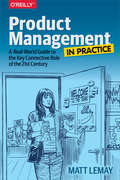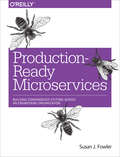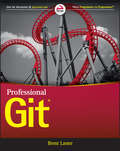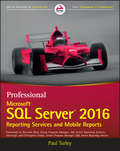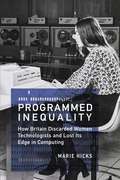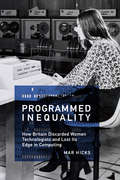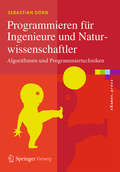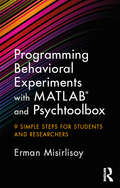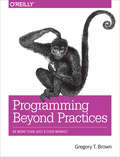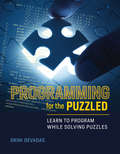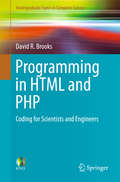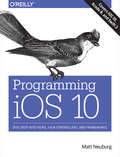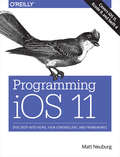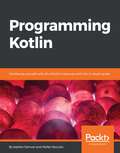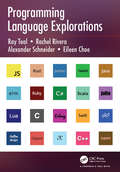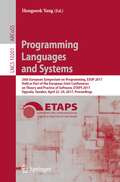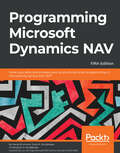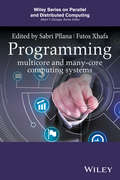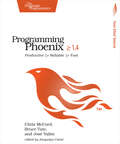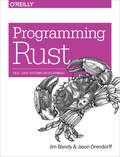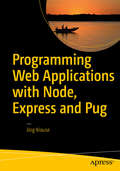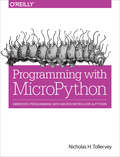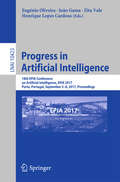- Table View
- List View
Product Management in Practice: A Real-World Guide to the Key Connective Role of the 21st Century
by Matt LeMayProduct management has become a critical connective role for modern organizations, from small technology startups to global corporate enterprises. And yet the day-to-day work of product management remains largely misunderstood. In theory, product management is about building products that people love. The real-world practice of product management is often about difficult conversations, practical compromises, and hard-won incremental gains.In this book, author Matt LeMay focuses on the CORE connective skills—communication, organization, research, execution—that can build a successful product management practice across industries, organizations, teams, and toolsets.For current and would-be product managers, this book explores:Real-world tactics for facilitating collaboration and communicationHow to talk to users and work with executivesThe importance of setting clear and actionable goalsUsing roadmaps to connect and align your teamA values-first approach to implementing Agile practicesStories that convey realities of product management in the fieldCommon behavioral traps that turn good product managers bad
Product Roadmaps Relaunched: How to Set Direction while Embracing Uncertainty
by C. Todd Lombardo Bruce Mccarthy Evan Ryan Michael ConnorsA good product roadmap is one of the most important and influential documents an organization can develop, publish, and continuously update. In fact, this one document can steer an entire organization when it comes to delivering on company strategy.This practical guide teaches you how to create an effective product roadmap, and demonstrates how to use the roadmap to align stakeholders and prioritize ideas and requests. With it, you’ll learn to communicate how your products will make your customers and organization successful.Whether you're a product manager, product owner, business analyst, program manager, project manager, scrum master, lead developer, designer, development manager, entrepreneur, or business owner, this book will show you how to:Articulate an inspiring vision and goals for your productPrioritize ruthlessly and scientificallyProtect against pursuing seemingly good ideas without evaluation and prioritizationEnsure alignment with stakeholdersInspire loyalty and over-delivery from your teamGet your sales team working with you instead of against youBring a user and buyer-centric approach to planning and decision-makingAnticipate opportunities and stay ahead of the gamePublish a comprehensive roadmap without overcommitting
Production-Ready Microservices: Building Standardized Systems Across an Engineering Organization
by Susan J. FowlerOne of the biggest challenges for organizations that have adopted microservice architecture is the lack of architectural, operational, and organizational standardization. After splitting a monolithic application or building a microservice ecosystem from scratch, many engineers are left wondering what's next. In this practical book, author Susan Fowler presents a set of microservice standards in depth, drawing from her experience standardizing over a thousand microservices at Uber. You'll learn how to design microservices that are stable, reliable, scalable, fault tolerant, performant, monitored, documented, and prepared for any catastrophe.Explore production-readiness standards, including:Stability and Reliability: develop, deploy, introduce, and deprecate microservices; protect against dependency failuresScalability and Performance: learn essential components for achieving greater microservice efficiencyFault Tolerance and Catastrophe Preparedness: ensure availability by actively pushing microservices to fail in real timeMonitoring: learn how to monitor, log, and display key metrics; establish alerting and on-call proceduresDocumentation and Understanding: mitigate tradeoffs that come with microservice adoption, including organizational sprawl and technical debt
Professional Git
by Brent LasterLeverage the power of Git to smooth out the development cycle Professional Git takes a professional approach to learning this massively popular software development tool, and provides an up-to-date guide for new users. More than just a development manual, this book helps you get into the Git mindset—extensive discussion of corollaries to traditional systems as well as considerations unique to Git help you draw upon existing skills while looking out—and planning for—the differences. Connected labs and exercises are interspersed at key points to reinforce important concepts and deepen your understanding, and a focus on the practical goes beyond technical tutorials to help you integrate the Git model into your real-world workflow. Git greatly simplifies the software development cycle, enabling users to create, use, and switch between versions as easily as you switch between files. This book shows you how to harness that power and flexibility to streamline your development cycle. Understand the basic Git model and overall workflow Learn the Git versions of common source management concepts and commands Track changes, work with branches, and take advantage of Git's full functionality Avoid trip-ups and missteps common to new users Git works with the most popular software development tools and is used by almost all of the major technology companies. More than 40 percent of software developers use it as their primary source control tool, and that number continues to grow; the ability to work effectively with Git is rapidly approaching must-have status, and Professional Git is the comprehensive guide you need to get up to speed quickly.
Professional Microsoft SQL Server 2016 Reporting Services and Mobile Reports
by Christopher Finlan Paul Turley Riccardo MutiOptimize reporting and BI with Microsoft SQL Server 2016 Professional Microsoft SQL Server 2016 Reporting Services and Mobile Reports provides a comprehensive lesson in business intelligence (BI), operational reporting and Reporting Services architecture using a clear, concise tutorial approach. You'll learn effective report solution design based upon many years of experience with successful report solutions. Improve your own reports with advanced, best-practice design, usability, query design, and filtering techniques. Expert guidance provides insight into common report types and explains where each could be made more efficient, while providing step-by step instruction on Microsoft SQL Server 2016. All changes to the 2016 release are covered in detail, including improvements to the Visual Studio Report Designer (SQL Server Data Tools) and Report Builder, Mobile Dashboard Designer, the new Report Portal Interface, HTML-5 Rendering, Power BI integration, Custom Parameters Pane, and more. The Microsoft SQL Server 2016 release will include significant changes. New functionality, new capabilities, re-tooled processes, and changing support require a considerable update to existing knowledge. Whether you're starting from scratch or simply upgrading, this book is an essential guide to report design and business intelligence solutions. Understand BI fundamentals and Reporting Services architecture Learn the ingredients to a successful report design Get up to speed on Microsoft SQL Server 2016 Grasp the purpose behind common designs to optimize your reporting Microsoft SQL Server Reporting Services makes reporting faster, easier, and more powerful than ever in web, desktop and portal solutions. Compatibility with an extensive variety of data sources makes it a go-to solution for organizations across the globe. The 2016 release brings some of the biggest changes in years, and the full depth and breadth of these changes can create a serious snag in your workflow. For a clear tutorial geared toward the working professional, Professional Microsoft SQL Server 2016 Reporting Services and Mobile Reports is the ideal guide for getting up to speed and producing successful reports.
Programmed Inequality: How Britain Discarded Women Technologists and Lost Its Edge in Computing
by Marie HicksIn 1944, Britain led the world in electronic computing. By 1974, the British computer industry was all but extinct. What happened in the intervening thirty years holds lessons for all postindustrial superpowers. As Britain struggled to use technology to retain its global power, the nation's inability to manage its technical labor force hobbled its transition into the information age. In Programmed Inequality, Marie Hicks explores the story of labor feminization and gendered technocracy that undercut British efforts to computerize. That failure sprang from the government's systematic neglect of its largest trained technical workforce simply because they were women. Women were a hidden engine of growth in high technology from World War II to the 1960s. As computing experienced a gender flip, becoming male-identified in the 1960s and 1970s, labor problems grew into structural ones and gender discrimination caused the nation's largest computer user -- the civil service and sprawling public sector -- to make decisions that were disastrous for the British computer industry and the nation as a whole.Drawing on recently opened government files, personal interviews, and the archives of major British computer companies, Programmed Inequality takes aim at the fiction of technological meritocracy. Hicks explains why, even today, possessing technical skill is not enough to ensure that women will rise to the top in science and technology fields. Programmed Inequality shows how the disappearance of women from the field had grave macroeconomic consequences for Britain, and why the United States risks repeating those errors in the twenty-first century.
Programmed Inequality: How Britain Discarded Women Technologists and Lost Its Edge in Computing (History of Computing)
by Mar HicksHow Britain lost its early dominance in computing by systematically discriminating against its most qualified workers: women.In 1944, Britain led the world in electronic computing. By 1974, the British computer industry was all but extinct. What happened in the intervening thirty years holds lessons for all postindustrial superpowers. As Britain struggled to use technology to retain its global power, the nation's inability to manage its technical labor force hobbled its transition into the information age. In Programmed Inequality, Mar Hicks explores the story of labor feminization and gendered technocracy that undercut British efforts to computerize. That failure sprang from the government's systematic neglect of its largest trained technical workforce simply because they were women. Women were a hidden engine of growth in high technology from World War II to the 1960s. As computing experienced a gender flip, becoming male-identified in the 1960s and 1970s, labor problems grew into structural ones and gender discrimination caused the nation's largest computer user—the civil service and sprawling public sector—to make decisions that were disastrous for the British computer industry and the nation as a whole.Drawing on recently opened government files, personal interviews, and the archives of major British computer companies, Programmed Inequality takes aim at the fiction of technological meritocracy. Hicks explains why, even today, possessing technical skill is not enough to ensure that women will rise to the top in science and technology fields. Programmed Inequality shows how the disappearance of women from the field had grave macroeconomic consequences for Britain, and why the United States risks repeating those errors in the twenty-first century.
Programmieren für Ingenieure und Naturwissenschaftler
by Sebastian DörnZiel des Buches ist es, Studierenden der Ingenieur- oder Naturwissenschaften die Programmierung als Schlüsselqualifikation mit zahlreichen Anwendungsmöglichkeiten vorzustellen. Großer Wert wird auf eine praxisorientierte und verständliche Darstellung gelegt. Der Autor behandelt die Anwendungsbereiche des Operations Research, der Medizinischen Informatik und der Automatisierungstechnik. Neben der Darstellung objektorientierter Entwurfsmuster werden zentrale Programmierkonzepte und fortgeschrittene Datenstrukturen vorgestellt. Suchalgorithmen, Graphen, Automaten und reguläre Sprachen werden dem Leser praxisnah vermittelt. Die Grundlagen zur Bildverarbeitung im Bereich der Bildfilterung, Registrierung und Segmentierung runden das Buch ab.
Programming Behavioral Experiments with MATLAB and Psychtoolbox: 9 Simple Steps for Students and Researchers
by Erman MisirlisoyHuman behavior is fascinating so it’s no surprise that psychologists and neuroscientists spend their lives designing rigorous experiments to understand it. MATLAB is one of the most widely used pieces of software for designing and running behavioral experiments, and it opens up a world of quick and flexible experiment programming. This book offers a step-by-step guide to using MATLAB with Psychtoolbox to create customisable experiments. Its pocket size and simple language allow you to get straight to the point and help you to learn fast in order to complete your work in great time. In nine simple steps, it guides you all the way from setting parameters for your experiment to analysing the output. Gone are the daunting days of working through hundreds of irrelevant and complicated documents, as in this handy book, Erman Misirlisoy coaxes you in the right direction with his friendly and encouraging tricks and tips. If you want to learn how to develop your own experiments to collect and analyse behavioral data, then this book is a must-read. Whether you are a student in experimental psychology, a researcher in cognitive neuroscience, or simply someone who wants to run behavioral tasks on your friends for fun, this book will offer you the skills to succeed.
Programming Beyond Practices: Be More Than Just a Code Monkey
by Gregory T BrownWriting code is the easy part of your work as a software developer. This practical book lets you explore the other 90%--everything from requirements discovery and rapid prototyping to business analysis and designing for maintainability. Instead of providing neatly packaged advice from on high, author Gregory Brown presents detailed examples of the many problems developers encounter, including the thought process it takes to solve them.He does this in an unusual and entertaining fashion by making you the main character in a series of chapter-length stories. As these stories progress, the examples become more complex, and your responsibilities increase. Together, these stories take you on a journey that will make you question and refine the way you think about, and work on, software projects.Steps in this unique journey include:Using prototypes to explore project ideasSpotting hidden dependencies in incremental changesIdentifying the pain points of service integrationsDeveloping a rigorous approach towards problem-solvingDesigning software from the bottom upData modeling in an imperfect worldGradual process improvement as an antidote for over-commitmentThe future of software development
Programming for the Puzzled: Learn to Program While Solving Puzzles (The\mit Press Ser.)
by Srini DevadasLearning programming with one of “the coolest applications around”: algorithmic puzzles ranging from scheduling selfie time to verifying the six degrees of separation hypothesis.This book builds a bridge between the recreational world of algorithmic puzzles (puzzles that can be solved by algorithms) and the pragmatic world of computer programming, teaching readers to program while solving puzzles. Few introductory students want to program for programming's sake. Puzzles are real-world applications that are attention grabbing, intriguing, and easy to describe. Each lesson starts with the description of a puzzle. After a failed attempt or two at solving the puzzle, the reader arrives at an Aha! moment—a search strategy, data structure, or mathematical fact—and the solution presents itself. The solution to the puzzle becomes the specification of the code to be written. Readers will thus know what the code is supposed to do before seeing the code itself. This represents a pedagogical philosophy that decouples understanding the functionality of the code from understanding programming language syntax and semantics. Python syntax and semantics required to understand the code are explained as needed for each puzzle.Readers need only the rudimentary grasp of programming concepts that can be obtained from introductory or AP computer science classes in high school. The book includes more than twenty puzzles and more than seventy programming exercises that vary in difficulty. Many of the puzzles are well known and have appeared in publications and on websites in many variations. They range from scheduling selfie time with celebrities to solving Sudoku problems in seconds to verifying the six degrees of separation hypothesis. The code for selected puzzle solutions is downloadable from the book's website; the code for all puzzle solutions is available to instructors.
Programming in HTML and PHP
by David R. BrooksThis concise and accessible textbook will enable readers to quickly develop the working skills necessary to solve computational problems in a server-based environment, using HTML and PHP. The importance of learning by example (as opposed to simply learning by copying) is emphasized through extensive use of hands-on exercises and examples, with a specific focus on useful science and engineering applications. The clearly-written text is designed to be simple to follow for the novice student, without requiring any background in programming or mathematics beyond algebra. Topics and features: describes the creation of HTML pages and the characteristics of HTML documents, showing how to use HTML tables, forms, lists, and frames to organize documents for use with PHP applications; explains how to set up a PHP environment, using a local or remote server; introduces the capabilities and syntax of the PHP language, including coverage of array syntax and use; examines user-defined functions in programming, summarizing PHP functions for reading and writing files, viewing the content of variables, and manipulating strings; reviews the PHP GD graphics library, presenting applications for creating pie charts, bar graphs, and line graphs suitable for displaying scientific data; includes appendices listing HTML and ASCII special characters, and highlighting the essential basic strategies for solving computational problems. Supplying all of the tools necessary to begin coding in HTML and PHP, this invaluable textbook is ideal for undergraduate students taking introductory courses in programming. The book will also serve as a helpful self-study text for professionals in any technical field.
Programming iOS 10: Dive Deep into Views, View Controllers, and Frameworks
by Matt NeuburgIf you're grounded in the basics of Swift, Xcode, and the Cocoa framework, this book provides a structured explanation of all essential real-world iOS app components. Through deep exploration and copious code examples, you'll learn how to create views, manipulate view controllers, and add features from iOS frameworks.Stay up-to-date on iOS 10 innovations, such as property animators, force touch, speech recognition, and the User Notification framework, as well as Xcode 8 improvements for autolayout and asset catalogs. All example code (now rewritten in Swift 3) is available on GitHub for you to download, study, and run.Create, arrange, draw, layer, and animate views that respond to touchUse view controllers to manage multiple screens of interfaceMaster interface classes for scroll views, table views, text, popovers, split views, web views, and controlsDive into frameworks for sound, video, maps, and sensorsAccess user libraries: music, photos, contacts, and calendarExplore additional topics, including files, networking, and threadsWant to brush up on the basics? Pick up iOS 10 Programming Fundamentals with Swift (978-1-491-97007-2) to learn about Swift, Xcode, and Cocoa. Together with Programming iOS 10, you'll gain a solid, rigorous, and practical understanding of iOS 10 development.
Programming iOS 11: Dive Deep into Views, View Controllers, and Frameworks
by Matt NeuburgIf you’re grounded in the basics of Swift, Xcode, and the Cocoa framework, this book provides a structured explanation of all essential real-world iOS app components. Through deep exploration and copious code examples, you’ll learn how to create views, manipulate view controllers, and add features from iOS frameworks.Create, arrange, draw, layer, and animate views that respond to touchUse view controllers to manage multiple screens of interfaceMaster interface classes for scroll views, table views, text, popovers, split views, web views, and controlsDive into frameworks for sound, video, maps, and sensorsAccess user libraries: music, photos, contacts, and calendarExplore additional topics, including files, networking, and threadsStay up-to-date on iOS 11 innovations, such as:Drag and dropAutolayout changes (including the new safe area)Stretchable navigation barsTable cell swipe buttonsDynamic type improvementsOffline sound file rendering, image picker controller changes, new map annotation types, and moreAll example code (now rewritten in Swift 4) is available on GitHub for you to download, study, and run.Want to brush up on the basics? Pick up iOS 11 Programming Fundamentals with Swift to learn about Swift, Xcode, and Cocoa. Together with Programming iOS 11, you’ll gain a solid, rigorous, and practical understanding of iOS 11 development.
Programming Kotlin
by Stefan Bocutiu Stephen SamuelFamiliarize yourself with all of Kotlin's features with this in-depth guide About This Book • Get a thorough introduction to Kotlin • Learn to use Java code alongside Kotlin without any hiccups • Get a complete overview of null safety, Generics, and many more interesting features Who This Book Is For The book is for existing Java developers who want to learn more about an alternative JVM language. If you want to see what Kotlin has to offer, this book is ideal for you. What You Will Learn • Use new features to write structured and readable object-oriented code • Find out how to use lambdas and higher order functions to write clean, reusable, and simple code • Write unit tests and integrate Kotlin tests with Java code in a transitioning code base • Write real-world production code in Kotlin in the style of microservices • Leverage Kotlin's extensions to the Java collections library • Use destructuring expressions and find out how to write your own • Write code that avoids null pointer errors and see how Java-nullable code can integrate with features in a Kotlin codebase • Discover how to write functions in Kotlin, see the new features available, and extend existing libraries • Learn to write an algebraic data types and figure out when they should be used In Detail Kotlin has been making waves ever since it was open sourced by JetBrains in 2011; it has been praised by developers across the world and is already being adopted by companies. This book provides a detailed introduction to Kotlin that shows you all its features and will enable you to write Kotlin code to production. We start with the basics: get you familiar with running Kotlin code, setting up, tools, and instructions that you can use to write basic programs. Next, we cover object oriented code: functions, lambdas, and properties – all while using Kotlin's new features. Then, we move on to null safety aspects and type parameterization. We show you how to destructure expressions and even write your own. We also take you through important topics like testing, concurrency, microservices, and a whole lot more. By the end of this book you will be able to compose different services and build your own applications. Style and approach An easy to follow guide that covers the full set of features in Kotlin programming.
Programming Language Explorations
by Ray Toal Rachel Rivera Alexander Schneider Eileen Choe<P><P><i>Advisory: Bookshare has learned that this book offers only partial accessibility. We have kept it in the collection because it is useful for some of our members. Benetech is actively working on projects to improve accessibility issues such as these.</i> <P><P> Programming Language Explorations is a tour of several modern programming languages in use today. The book teaches fundamental language concepts using a language-by-language approach. As each language is presented, the authors introduce new concepts as they appear, and revisit familiar ones, comparing their implementation with those from languages seen in prior chapters. The goal is to present and explain common theoretical concepts of language design and usage, illustrated in the context of practical language overviews. <P><P>Twelve languages have been carefully chosen to illustrate a wide range of programming styles and paradigms. The book introduces each language with a common trio of example programs, and continues with a brief tour of its basic elements, type system, functional forms, scoping rules, concurrency patterns, and sometimes, metaprogramming facilities. <P><P>Each language chapter ends with a summary, pointers to open source projects, references to materials for further study, and a collection of exercises, designed as further explorations. Following the twelve featured language chapters, the authors provide a brief tour of over two dozen additional languages, and a summary chapter bringing together many of the questions explored throughout the text. <P><P>Targeted to both professionals and advanced college undergraduates looking to expand the range of languages and programming patterns they can apply in their work and studies, the book pays attention to modern programming practice, covers cutting-edge languages and patterns, and provides many runnable examples, all of which can be found in an online GitHub repository. The exploration style places this book between a tutorial and a reference, with a focus on the concepts and practices underlying programming language design and usage. Instructors looking for material to supplement a programming languages or software engineering course may find the approach unconventional, but hopefully, a lot more fun.
Programming Languages and Systems
by Hongseok YangThis book constitutes the proceedings of the 26th European Symposium on Programming, ESOP 2017, which took place in Uppsala, Sweden in April 2017, held as Part of the European Joint Conferences on Theory and Practice of Software, ETAPS 2017. The 36 papers presented in this volume were carefully reviewed and selected from 112 submissions. They cover traditional as well as emerging topics in programming languages. In detail they deal with semantic foundation and type system for probabilistic programming; techniqu3es for verifying concurrent or higher-order programs; programming languages for arrays or web data; program analysis and verification of non-standard program properties; foundation and application of interactive theorem proving; graph rewriting; separation logic; session type; type theory; and implicit computational complexity.
Programming Languages and Systems: 26th European Symposium on Programming, ESOP 2017, Held as Part of the European Joint Conferences on Theory and Practice of Software, ETAPS 2017, Uppsala, Sweden, April 22–29, 2017, Proceedings (Lecture Notes in Computer Science #10201)
by Hongseok YangThis book constitutes the proceedings of the 26th European Symposium on Programming, ESOP 2017, which took place in Uppsala, Sweden in April 2017, held as Part of the European Joint Conferences on Theory and Practice of Software, ETAPS 2017.The 36 papers presented in this volume were carefully reviewed and selected from 112 submissions. They cover traditional as well as emerging topics in programming languages. In detail they deal with semantic foundation and type system for probabilistic programming; techniqu3es for verifying concurrent or higher-order programs; programming languages for arrays or web data; program analysis and verification of non-standard program properties; foundation and application of interactive theorem proving; graph rewriting; separation logic; session type; type theory; and implicit computational complexity.
Programming Microsoft Dynamics NAV - Fifth Edition: Hone your skills and increase your productivity when programming in Microsoft Dynamics NAV 2017, 5th Edition
by Mark Brummel Christopher D. Studebaker David A. StudebakerCustomize your NAV applications About This Book • Gain from the insights and methods of industry-leading experts and tailor your applications to best suit the needs of your business • Learn through the detailed explanations and useful examples that are presented in a logical, step-by-step manner • This comprehensive guide is written with the goals of being used as a classroom text, a self-study text, and as a handy in-depth reference guide Who This Book Is For This book will appeal to all those who want to learn about NAV's powerful and extensive built-in development capabilities. It assumes that you understand programming and are familiar with business application software, although you aren't expected to have worked with NAV before. ERP consultants and managers of NAV development will also find the book helpful. What You Will Learn • Productively and effectively use the development tools that are built into Dynamics NAV • Understand the strengths of NAV's development tools and how they can be applied to address functional business requirements • Introduction to programming using the C/AL language in the C/SIDE Development Environment • Explore functional design and development using C/AL • Leverage advanced NAV development features and tools • Get to know the best practices to design and develop modifications of new functionality integrated with the standard NAV software In Detail Microsoft Dynamics NAV is a full business solution suite, and a complete ERP solution, which contains a robust set of development tools to support customization and enhancement. These tools help in greater control over financials and can simplify supply chain, manufacturing, and operations. This book will take you from an introduction to Dynamics NAV and its integrated development tools to being a productive developer in the Dynamics NAV Development Environment. You will find this book very useful if you want to evaluate the product's development capabilities or need to manage Dynamics NAV based projects. It will teach you about the NAV application structure, the C/SIDE development environment, the C/AL language paired with the improved editor, the construction and uses of each object type, and how it all fits together to build universal applications. With this new edition, you will be able to understand how to design and develop using Patterns and new features such as Extensions and Events. Style and approach This book is filled with examples and will serve as a comprehensive reference guide, complementing NAV's Help files.
Programming Multicore and Many-core Computing Systems
by Fatos Xhafa Sabri PllanaProgramming multi-core and many-core computing systems Sabri Pllana, Linnaeus University, Sweden Fatos Xhafa, Technical University of Catalonia, Spain Provides state-of-the-art methods for programming multi-core and many-core systems The book comprises a selection of twenty two chapters covering: fundamental techniques and algorithms; programming approaches; methodologies and frameworks; scheduling and management; testing and evaluation methodologies; and case studies for programming multi-core and many-core systems. Program development for multi-core processors, especially for heterogeneous multi-core processors, is significantly more complex than for single-core processors. However, programmers have been traditionally trained for the development of sequential programs, and only a small percentage of them have experience with parallel programming. In the past, only a relatively small group of programmers interested in High Performance Computing (HPC) was concerned with the parallel programming issues, but the situation has changed dramatically with the appearance of multi-core processors on commonly used computing systems. It is expected that with the pervasiveness of multi-core processors, parallel programming will become mainstream. The pervasiveness of multi-core processors affects a large spectrum of systems, from embedded and general-purpose, to high-end computing systems. This book assists programmers in mastering the efficient programming of multi-core systems, which is of paramount importance for the software-intensive industry towards a more effective product-development cycle. Key features: Lessons, challenges, and roadmaps ahead. Contains real world examples and case studies. Helps programmers in mastering the efficient programming of multi-core and many-core systems. The book serves as a reference for a larger audience of practitioners, young researchers and graduate level students. A basic level of programming knowledge is required to use this book.
Programming Phoenix 1.4: Productive |> Reliable |> Fast
by Chris McCord Bruce Tate Jose ValimDon't accept the compromise between fast and beautiful: you can have it all. Phoenix creator Chris McCord, Elixir creator Jose Valim, and award-winning author Bruce Tate walk you through building an application that's fast and reliable. At every step, you'll learn from the Phoenix creators not just what to do, but why. Packed with insider insights and completely updated for Phoenix 1.4, this definitive guide will be your constant companion in your journey from Phoenix novice to expert, as you build the next generation of web applications. Phoenix is the long-awaited web framework based on Elixir, the highly concurrent language that combines a beautiful syntax with rich metaprogramming. The best way to learn Phoenix is to code, and you'll get to attack some interesting problems. Start working with controllers, views, and templates within the first few pages. Build an in-memory context, and then back it with an Ecto database layer, complete with changesets and constraints that keep readers informed and your database integrity intact. Craft your own interactive application based on the channels API for the real-time applications that this ecosystem made famous. Write your own authentication plugs, and use the OTP layer for supervised services. Organize code with modular umbrella projects. This edition is fully updated for Phoenix 1.4, with a new chapter on using Channel Presence to find out who's connected, even on a distributed application. Use the new generators and the new ExUnit features to organize tests and make Ecto tests concurrent. This is a book by developers and for developers, and we know how to help you ramp up quickly. Any book can tell you what to do. When you've finished this one, you'll also know why to do it. What You Need:To work through this book, you will need a computer capable of running Erlang 18 or higher, Elixir 1.5 or higher, and Phoenix 1.4 or higher. A rudimentary knowledge of Elixir is also highly recommended.
Programming Rust: Fast, Safe Systems Development
by Jim Blandy Jason OrendorffRust is a new systems programming language that combines the performance and low-level control of C and C++ with memory safety and thread safety. Rust’s modern, flexible types ensure your program is free of null pointer dereferences, double frees, dangling pointers, and similar bugs, all at compile time, without runtime overhead. In multi-threaded code, Rust catches data races at compile time, making concurrency much easier to use.Written by two experienced systems programmers, this book explains how Rust manages to bridge the gap between performance and safety, and how you can take advantage of it. Topics include:How Rust represents values in memory (with diagrams)Complete explanations of ownership, moves, borrows, and lifetimesCargo, rustdoc, unit tests, and how to publish your code on crates.io, Rust’s public package repositoryHigh-level features like generic code, closures, collections, and iterators that make Rust productive and flexibleConcurrency in Rust: threads, mutexes, channels, and atomics, all much safer to use than in C or C++Unsafe code, and how to preserve the integrity of ordinary code that uses itExtended examples illustrating how pieces of the language fit together
Programming Web Applications with Node, Express and Pug
by Jörg KrauseLearn how to program modern web applications using the full Node.js platform, including Node.js on the server, Express for middleware and routing, and Pug (formerly Jade) to simplify the creation of views.Node.js is the foundation of all full JavaScript apps and plenty of books cover its full usage. This book focuses on how to use it to create server-based, modern web applications. Using Node.js alongside Express and Pug - the brand new version of Jade - you can create modern web applications solely using JavaScript. This book teaches you how to structure and build your app from scratch, and make development easy. What You Will LearnUse NodeJS in general and particularly the features require to create web applicationsUnderstand middleware and how to develop using the Express frameworkExplore the template engine Pug (formerly Jade) and how you can integrate it with ExpressSet up a complete development environment on both Linux and WindowsWho This Book Is For Developers of web applications who come from Java/J2EE, ASP.NET, PHP, Ruby on Rails and want to explore the capabilities of JavaScript based server apps. It’s suitable for beginners that have a basic understanding of JavaScript already.
Programming with MicroPython: Embedded Programming with Microcontrollers and Python
by Nicholas H. TollerveyIt’s an exciting time to get involved with MicroPython, the re-implementation of Python 3 for microcontrollers and embedded systems. This practical guide delivers the knowledge you need to roll up your sleeves and create exceptional embedded projects with this lean and efficient programming language. If you’re familiar with Python as a programmer, educator, or maker, you’re ready to learn—and have fun along the way.Author Nicholas Tollervey takes you on a journey from first steps to advanced projects. You’ll explore the types of devices that run MicroPython, and examine how the language uses and interacts with hardware to process input, connect to the outside world, communicate wirelessly, make sounds and music, and drive robotics projects.Work with MicroPython on four typical devices: PyBoard, the micro:bit, Adafruit’s Circuit Playground Express, and ESP8266/ESP32 boardsExplore a framework that helps you generate, evaluate, and evolve embedded projects that solve real problemsDive into practical MicroPython examples: visual feedback, input and sensing, GPIO, networking, sound and music, and roboticsLearn how idiomatic MicroPython helps you express a lot with the minimum of resourcesTake the next step by getting involved with the Python community
Progress in Artificial Intelligence: 18th EPIA Conference on Artificial Intelligence, EPIA 2017, Porto, Portugal, September 5-8, 2017, Proceedings (Lecture Notes in Computer Science #10423)
by Zita Vale Eugénio Oliveira João Gama Henrique Lopes CardosoThis book constitutes the refereed proceedings of the 18th Portuguese Conference on Artificial Intelligence, EPIA 2017, held in Porto, Portugal, in September 2017. The 69 revised full papers and 2 short papers presented were carefully reviewed and selected from a total of 177 submissions. The papers are organized in 16 tracks devoted to the following topics: agent-based modelling for criminological research (ABM4Crime), artificial intelligence in cyber-physical and distributed embedded systems (AICPDES), artificial intelligence in games (AIG), artificial intelligence in medicine (AIM), artificial intelligence in power and energy systems (AIPES), artificial intelligence in transportation systems (AITS), artificial life and evolutionary algorithms (ALEA), ambient intelligence and affective environments (AmIA), business applications of artificial intelligence (BAAI), intelligent robotics (IROBOT), knowledge discovery and business intelligence (KDBI), knowledge representation and reasoning (KRR), multi-agent systems: theory and applications (MASTA), software engineering for autonomous and intelligent systems (SE4AIS), social simulation and modelling (SSM), and text mining and applications (TeMA).
